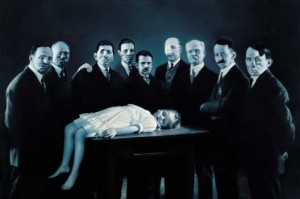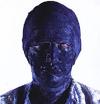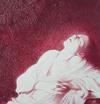FLASH ART, The World's Leading Art Magazine – January 1, 1998
Retrospective at the State Russian Museum, St. Petersburg, 1998
GOTTFRIED HELNWEIN
Austrian-born artist Gottfried Helnwein is a brave, often overlooked, and unfairly compared virtuoso of versatility. In his work, he forces us to confront, via his visual wit, brio, and candor, the human face of violence and angst. The recent solo retrospective of over 400 works on view at the Marble Palace, the contemporary wing of the Russian State Museum in St. Petersburg, proved Helnwein a master of many forms: from painting to installation, from photography to illustration, from sculpture to performance. His flexibility is so impressive that he almost seems a hoax.

Helnwein earned his first gallery show in Austria over 20 years ago by driving around dressed in a Nazi uniform, his head bandaged, fake blood spilling from his mouth; this caught the eye of art dealer Peter Grebner, who still represents the artist via Vienna's gallery Spectrum. Nazis and rock stars seem to be a theme for Helnwein. His most recent canvases feature Hitler as a daddy-like figure, posing kindly with children; previous standout paintings such as the mysterious Epiphanie (1996), feature uniformed soldiers inspecting a naked baby boy held up for display by an Aryan goddess.
His starling photographs are some of the most eerily haunting portraits of such musicians and megastar artists as Michael Jackson, Keith Richards, Keith Harring, and William S. Burroughs - eerily haunting because they are so real and unflattering, casting a whole new light on faces we have seen again and again and again. In the catalogue to a 1996 solo show in Otaru, Japan, Burroughs wrote about Helnwein, "It is the function of the artist to evoke the experience of surprised recognition: to show the viewer what he knows, but does not know that he knows."
One of the artist's most outstanding works, Selektion (Ninth November Night) (1988), is a work consisting of giant photographs of children's faces reminiscent of concentration camp portraits. Selektion, a reminder of Reichskristallnacht, a catalytic event of the Holocaust in 1938, was first unveiled outside the Museum Ludwig in Cologne, where the photographs were slashed aggressively by neo-Nazis precisely across the images of the children's throats.
At the Marble Palace, Helnwein placed rough-looking statues of what appeared to be bandaged children in a raw, unrestored first floor room of the palace, to the astonishment of museum officials. He hung canvases of James Dean together in one tiny room, so that viewers would feel ambushed by images of the deceased actor. He lined up his self-portraits - often depicting himself in states of torture, even when abstract - creating a disturbing sense of self-obsession. He placed his signature all-blue canvases of neo-Madonnas and portraits of the famous in rows, conjuring the experience of being engulfed by an ocean wave. He proudly showcased one of his most clever series - 48 Portraits - a reaction to a parallel piece by Gerhard Richter, to whom Helnwein is most often - and inaccurately - compared.
Helnwein's diverse body of work also includes sinister renderings of cartoon characters, pencil drawings with sex and death as themes, images of maimed children, cover illustrations of TIME magazine, and gorgeous, lyrical portraits of his own children, possibly dreaming.
Helnwein's work prods us to react, yet not simply because it is "shocking". His main message in fact is: be brave. Be daring. And most importantly, be willing to confront even the darkest side of human nature - after all, it's something we cannot escape.
Reena Jana is a critic based in San Francisco.
January/February 1998/Flash Art 105
Gottfried Helnwein, RETROSPECTIVE AT THE STATE RUSSIAN MUSEUM ST. PETERSBURG, 1997
1998 FLASH ART, The World's Leading Art Magazine Reena Jana


